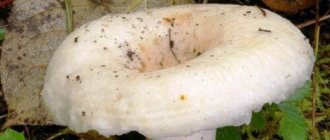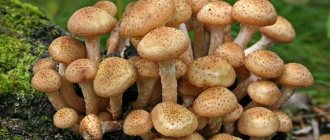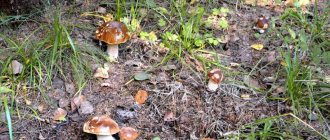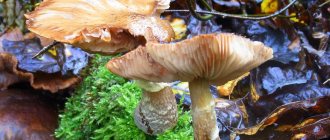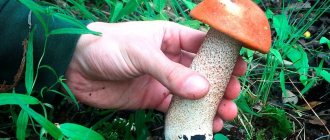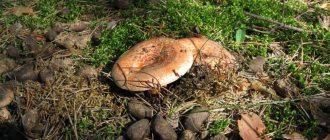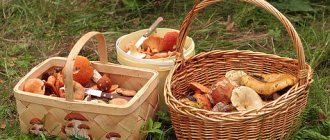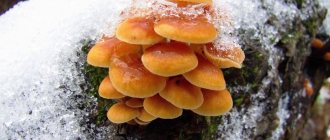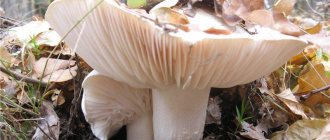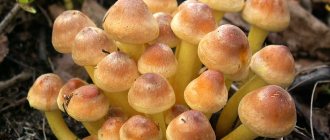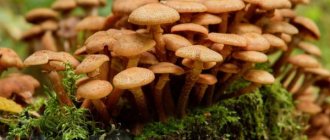By the end of summer, mushrooms and berries had ripened in the forests of St. Petersburg and the Leningrad region. The rains brought coolness after the long summer heat and the mushrooms began to grow by leaps and bounds. Residents are already boasting about their seasonal catch on social networks, demonstrating the size of their “catch.” Despite the bad weather and cold, residents collect gifts from the forest.
However, hunting for mushrooms is far from safe. If you want to find a large mycelium, you can go far into the forest and meet large local inhabitants there. Moreover, it is not a fact that they will welcome an uninvited guest.
What kind of mushrooms does a moose eat?
Autumn is the time for mushrooms. And the moose take this into account. From their point of view, boletus is a mushroom to all mushrooms, boletus is a silver medalist, and boletus, although among the winners, is only in third place.
Interesting materials:
How to go to work with a Sim in Sims 4? How to ask for time off from work to be released? How to switch from one desktop to another? How to move shortcuts on a laptop desktop? How to move an icon to the desktop? How to move an application to the desktop? How to move an application to a second desktop? How to move Steam to desktop? How to transfer Alice to the desktop? How to transfer information from the Internet to your desktop?
Which dangerous animals can you find in the forest?
Mushroom picker, author of the channel “Mushroom Experts of the Russian Federation” Nikolai Budnik, in a conversation with NEVSKY NEWS, said that the likelihood of meeting wild boars in the forest is now very low, but bears go foraging for berries, just like people. Moreover, you can stumble upon a clubfoot completely by accident. Especially if you walk quietly and insinuatingly. But at the same time, meeting a bear is very rare.
“When picking mushrooms, a mushroom picker may encounter traces, even very fresh ones, of the vital activity of bears, but you won’t even hear the bears themselves. You can take a flare with you - a sharp, piercing whistle scares away a bear very well,” the expert said.
But danger in the forest comes not only from large animals. Insects also like to attack mushroom pickers and wild berry lovers. In addition to mosquitoes, midges and ticks, there are other equally pleasant flyers.
“Currently, the danger in the forest is the moose bloodsucker. This is a parasite that flies and bites painfully. Moreover, she can hide in hair, clothes and later crawl. Therefore, after the forest, be sure to inspect your body and clothes carefully. Keep forest equipment separate from other clothes so that the elk bloodsucker or other tick does not crawl onto you and your pets,” advised Nikolai Budnik.
westrussia.org / Press service of the Kaliningrad Regional History and Art Museum
From the 20th of August in the Leningrad region, the moose race begins - seasonal migration, said Pavel Glazkov, candidate of biological sciences and author of the YouTube channel “Each creature in pairs” . At this time, the likelihood of meeting moose on the roads, as well as in the forest, increases sharply. Most often, moose wander along the roads in the evenings, at night and in the morning.
“Moose walk and rage from the evening, all night and until the morning. This will last until early to mid October. For his fellow tribesmen, he is aggressive, males fight with each other. Mushroom pickers can also see moose, but only if they move quietly through the forest,” Glazkov said.
At the same time, he noted that now mushroom pickers need, on the contrary, to make more noise in the forest so as not to accidentally get caught during elk showdowns. During this period, moose fight for the attention of females and may perceive random people as a threat to their personal happiness.
In addition, you can find snakes in the forest. By September, according to the biologist, they begin to concentrate around their wintering grounds. Later, the grass will begin to wither, and the snakes will be better visible, and therefore there will be a chance to avoid the creeping inhabitants.
“Snake bite is especially dangerous if a person is allergic. The snakes themselves, if they hear vibrations from a person, try to crawl away faster,” the biologist noted.
pixnio.com/pixnio
Mushroom dangers
However, mushrooms can also cause harm. We must not forget that phytopathogenic fungi that grow in an undisturbed ecological system can become a very serious safety problem. Usually not a threat, in artificially created conditions or in places where humans live, they can cause skin diseases - dermatomycosis, and sometimes serious damage to internal organs - deep mycoses. And this applies not only to people, but also to animals.
Poisoning with “traditional” poisonous mushrooms can pose a very great danger to humans. In some cases, even death is possible. Such poisonings are usually caused by eating highly toxic or
Plant symbiosis
Mycorrhiza-forming fungi, which are the third conditional group, are much less amenable to artificial cultivation. During development, they are closely associated with the roots of large trees, forming mycorrhiza on them - a kind of root system. In this case, a full-fledged symbiosis occurs, since the tree and the mushroom are equally useful to each other. The tree species provides the mushroom with the energy it needs, and it, in turn, provides the tree with the necessary mineral nutrients. Mainly phosphorus and nitrogen.
How do mushrooms eat? The underground part spreads densely in the soil, entwining the root of the main plant and performing the function of root hairs. Part of the hyphae, penetrating the root system of the main tree, extracts nutrients from it. The other extracts water, mineral salts and other soluble substances, mainly nitrogenous, from the soil. The substances obtained in this way partially enter the root system of the main plant, and also serve as a nutritional composition for the fungus itself.
It is also interesting that mycorrhiza-forming plants can develop without the root system of a higher plant. But in this case, the fruiting bodies of this fungus are not formed. This is exactly what happens when cultivating porcini mushrooms and related subspecies (boletus, boletus) at home. That is why mushrooms of this group are not artificially cultivated. Although there are no rules without exceptions. For example, in France and Germany it is very common to grow it on the roots of beech and oak seedlings.
And afraid of people?
People are the most terrible predators on earth, and everyone has different habits and thoughts. Glazkov noted that hunting is now open in the forest, and therefore it is not only mushroom pickers who are scurrying through the thickets in search of prey.
“To be safe in the forest, do not wear camouflage clothes - choose the brightest ones possible to stand out in the forest. Even if you get lost, it will be easier to find you,” emphasized Pavel Glazkov.
For those who go into the forest with children, the expert advises taking whistles for both adults and children. This will create additional noise. In addition, if someone from the company sees an animal, they won’t have to shout, but simply whistle. In addition to whistles, Glazkov advises taking with you a battery, a power bank for charging your phone, matches and a compass.
FBA "Economy Today" / Evgenia Avramenko
The mushroom season has started in the forests. Caps of edible and inedible mushrooms flooded green areas in St. Petersburg and the Leningrad region. NEVSKIE NEWS reported where it is better to go for a big “catch”, and also warned about deceiving mushrooms.
Diversity
The biological and ecological diversity of the kingdom is enormous. It is one of the largest forms of living organisms that are an integral part of all terrestrial and aquatic ecological systems. According to modern research, from 100 to 250 thousand different species of mushrooms are known today.
In 2008, in the kingdom of Fungi, scientists counted 36 classes, 140 orders, 560 families and 8283 common generic names for representatives of this species. Impressive numbers! Of course, mushrooms occupy an important niche in ecological interaction with humans. They are present in almost any natural environment: in water, on land, on all kinds of substrates.
How do mushrooms eat? The short answer is quite simple: they are decomposers, that is, they decompose all kinds of organic materials, while contributing to the formation of new fertile layers of soil. This can be primitively considered nutrition. But we should not forget that such processes play a rather important role in the ecology of the entire biosphere.
The benefits of chanterelles for the body
The unique, balanced composition of chanterelles, rich in vitamins and minerals, allows them to be widely used in both traditional and folk medicine. The benefits of eating these mushrooms are difficult to overestimate. If you ask yourself whether it is possible to eat chanterelle mushrooms raw, it is worth considering that during heat treatment the described properties are reduced to a minimum: already at 50 o C they cease to be so useful.
The beneficial effects of chanterelles on the body:
- remove heavy salts;
- help in the treatment of viral infections and sore throat;
- contribute to the correct functioning of the cardiovascular system;
- strengthen muscles, toning them;
- relieve irritability, relieve fatigue;
- improve vision, hair, nails and skin condition;
- effectively fight varicose veins;
- help with wound healing and elimination of skin abscesses;
- effective against furunculosis;
- significantly strengthen the immune system;
- get rid of parasites in the body and their eggs;
- actively contribute to the treatment of tuberculosis, being a natural antibiotic for the body;
- help in the treatment of obesity, as they are rich in the enzyme ergosterol, which also affects the liver, has a positive effect on its enzymes, and can fight hepatitis C;
- support the health of the gastrointestinal tract, with a particularly beneficial effect on the pancreas.
If it is still not entirely clear whether raw chanterelles can be eaten, it is worth noting that they even help in the treatment of rickets, osteoporosis and anemia, restore the intestinal microflora in case of dysbacteriosis, and are excellent helpers for the body in early forms of cancer. Mushrooms remove toxins and suppress allergic reactions.
In addition, chanterelles are even used in cosmetology, because their extract helps in the fight against skin fungus and inflammation, acne and bacterial infections. Also, creams based on these mushrooms actively moisturize and nourish the skin with many beneficial microelements.
Who eats the fox?
Wondering " Who eats the fox"
? you immediately need to answer - lynx. The lynx is an animal that lives next to the fox. These are very experienced hunters with powerful jaws.
Interesting materials:
How to change the name in VK messenger? How to change your name in VK to be accepted? How to change the name in VK Connect? How to change the name in VK to any 2022? How to change the card in Ads Manager? How to change the category on Twitch team? How to change content on tik tok? How to change your face on Snapchat? How to change login in Odnoklassniki 2022? How to change login in Outlook?
Lynx
Meeting this large yellow-red forest “cat” with the famous “tassels” on its ears is a great success. Even hunters encounter lynx extremely rarely. At the same time, it does not pose a danger to humans, unless it is suddenly infected with rabies.
The lynx is flexible, dexterous and strong, and can climb trees and swim well. And deep snow is not a hindrance for her - because of her strong, furry paws. The lynx is also cunning - sometimes it checks the traps and traps of hunters before they themselves and drags away other people's prey. Sometimes it can wait for hours for a prey (hare, deer, roe deer, bird) in ambush, then quietly and unnoticed to sneak up and jump on it. If you can’t catch it the first time, the lynx can hunt for the same animal all day long. By the way, when entering the countryside, the lynx also hunts cats - almost their own kind.
Lynxes prefer to settle in secluded places - for example, in holes under trees. They are not shy about occupying other people's holes.
Lynx cubs are furry and blind for the first few days. By the way, both parents raise lynx cubs, and this is a rather rare case in the animal environment.
How not to become lunch?
First of all, in order not to run into large animals, mushroom picker Nikolai Budnik advises not to walk quietly. Even songs can be used so that the appearance of a person in the forest does not come as a surprise to the animals.
“To avoid running into adventures, you cannot walk quietly in the forest. You must make noise, talk, sing, whistle, and walk loudly. Then there is almost no chance of meeting any animal. Animals are shy and they will hear you earlier and run away,” Budnik noted.
The same technique is recommended by biologist Pavel Glazkov . According to him, talking in the forest is a wonderful habit that should be adopted by residents of the Urals, where the number of dangerous animals in the forest is several times higher than in the Leningrad region.
“Make more noise in the forest, shout at each other. In the Urals, in the forests, people always do this. Our forests are often quiet. It is better to get into the habit of making maximum noise, then the likelihood of encountering wild animals will be reduced to a minimum. If an elk hears a noise from a branch, he can go out and see if it’s his competitor coming. And if a person makes sounds, the elk will immediately run away,” Glazkov gave an example.
pixabay.com/
The expert noted that there were cases when a moose attacked a person in the fall, but what exactly provoked the animal’s aggression is unknown. While moose compete for the attention of the opposite sex, they noisily walk through the forest, break branches, and show that they are the fearless males here. When meeting such a macho man, a person should talk to him. Not a heart-to-heart, but so that the elk doesn’t mistake the mushroom picker for another sparring partner.
“If you encounter a moose, you need to talk to it loudly: “Come on, let’s go away, I came here to pick mushrooms!” And step aside. Moose see poorly, but hear well. Next you need to take the basket, raise it above your head, you can take off the jacket and open it above your head - we need to visually increase in size for the animal. If there are two of you, then stand next to each other, raise your hands and wave. You will become a huge animal for the moose. The same method of protection can be used against a bear,” the biologist noted.
Next, the specialist advises to get away from the moose, but you can’t run from the bear. Running can provoke an attack; even the bear did not initially intend to attack a person. Moreover, escaping from a bear in its natural environment is an almost impossible task.
“You can’t physically run away from a bear. Therefore, we increase in size, make sounds, but not scream wildly,” Glazkov suggested.
In the Leningrad region, according to him, there are 3,150 brown bears, and there are now a lot of mushroom pickers walking through the forest. As the specialist noted, if bears really hunted people, then people would disappear in the hundreds, since, in fact, people are easy prey for a bear.
pixabay.com/
The situation with moose is simpler. If one of them is preparing to attack, then he begins to press his ears and throws his hooves forward. The movement is due to the fact that the elk hits the opponent with the hooves of its front paws, and not with its antlers.
“You can hide from a moose without running in a straight line, but stand behind a tree. The animal may lunge a few times and then see you running away and lose interest. But if you find yourself near a calf, the female will protect it to the last,” the expert warned.
Wolf
The wolf that lives in the forest looks like a shepherd dog - not surprising, because it is from the wolf that all dogs trace their ancestry. But you can still distinguish a wolf: it is larger than a dog and never curls its tail into a ring. And he doesn’t bark, but howls or growls. His fur is gray or reddish, thick and warm.
In fairy tales, the wolf is considered a treacherous, formidable and evil animal. He received such “fame” because he is a predator - he feeds on the flesh of animals caught during hunting: roe deer, hares, foxes, badgers, mice, marmots, wild geese and others. Sometimes wolves even kill their own kind.
Berries, fruits and mushrooms are also included in the wolf's diet. Sometimes wolves steal watermelons and melons from farms - all because these animals are often thirsty: they have a high need for water.
Wolves hunt mainly in packs - and not where they live. Even if the wolf's den is located near a farm or village, the animals will not give themselves away, because they will hunt far away - perhaps kilometers - from the “place of residence.”
When you see a wolf in the forest, it is better to retreat quietly, without looking him in the eye, or leave altogether. At the same time, it should not be considered a “bad” animal - it is a dexterous, fast, smart and strong animal. Wolves are also good parents: she-wolves feed their cubs with milk and always protect them from danger. Wolf cubs are born deaf and blind, so at first they are completely defenseless. When they grow up a little, their parents bring them live prey - not only for food, but for play and passive “hunting”.
Comprehensive application
Another huge significance of the vital activity of fungi has been revealed in all kinds of symbiotic communities. For example, mycorrhiza is an association of mycelium with the roots of higher plants, lichens are a symbiosis of a fungus with blue-green algae, etc. And representatives of the order Neocalimastigae serve as an obligatory component of the digestive process in ruminants. And there’s no need to talk about what animals eat mushrooms. Just start listing!
If we talk about humans, then, as we know, many types of mushrooms are used for food, medical and economic purposes. Culinary dishes of many cuisines around the world consist of this nutritious, tasty and healthy product. Their industrial breeding is very popular. There is a whole industry for the production of special materials for growing mushrooms. These products are intended for hobbyists who breed them at home. Such farmers need to know how mushrooms feed. The answers will have a significant impact on productivity and effort.
And the smallest microscopic fungi are often used in the food industry to prepare drinks, in the production of which the fermentation process is important. Medicine is not ignored either. Modern biotechnology for the production of antibiotics also uses some types of these microorganisms.
Simple classification
Talking about these amazing organisms, I would like to answer such an important and interesting question: “How do mushrooms feed?” The answers are very diverse, and this despite the fact that most of them belong to the same group - the basidiomycete class. Its representatives have quite serious differences in terms of natural food consumption.
If we classify the edible gifts of the forest according to how mushrooms grow and feed, then they can be divided into three main groups:
- humus saprotrophs;
- wood-decaying fungi;
- mycorrhiza-formers.
Humus saprotrophs include those that are distributed in the humus layer of the soil. Fungi feed on organic substances accumulated in dead wood, grass, etc. Interestingly, many of them grow in open spaces - fields, meadows, and steppe zones. This group primarily includes such well-known mushrooms as champignons, puffballs and dung beetles. How do carnivorous mushrooms feed? When there is nothing to profit from, they become saprotrophs. But they prefer to catch all kinds of living microorganisms. For this purpose, predators have special devices that allow them to catch prey. Most often these are sticky parts of the fungal body: hyphae, networks, mycelium branches. But there are also those that literally strangle the victim, rapidly increasing in size.
Most artificially cultivated fungi - xylotrophs - belong to the subgroup of saprotrophs. As a rule, they develop on stumps or dead wood. Among this species, it is worth noting the well-known oyster mushroom and shiitake. These mushrooms are valuable because they can be grown all year round under artificial conditions. In special premises, using, for example, waste from the woodworking industry, it is quite possible to organize a kind of farm.
